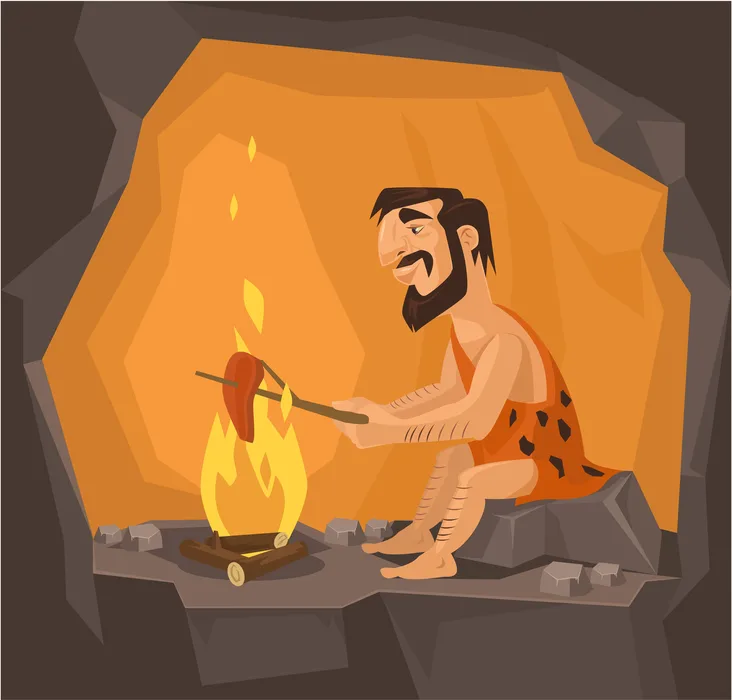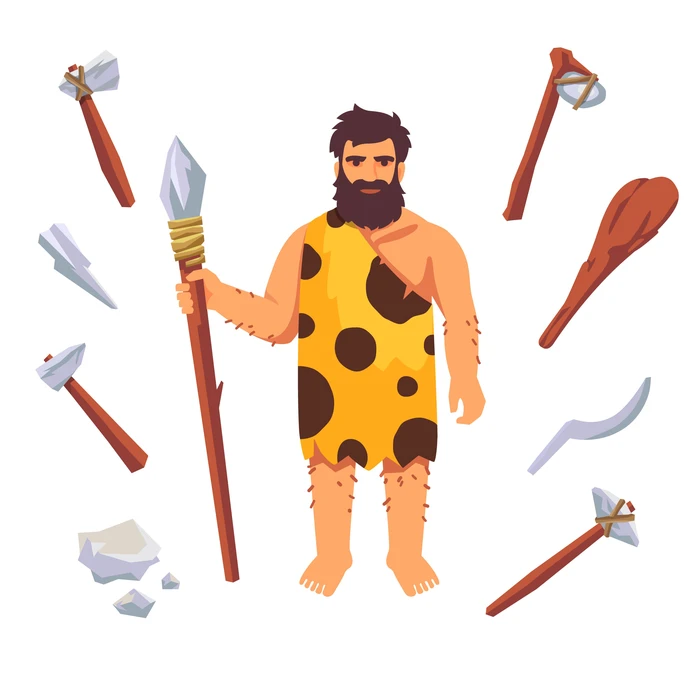Introduction
The first humans were hunters and gatherers who mainly relied on hunting for food. These hunter-gatherers made up a small group of no more than 100–150 individuals. They used to wander about looking for food. There were many early humans living there at the time- Neanderthals, homo sapiens, homo Rhodesians, etc. Only Homo sapiens survived the onset of the Stone Age, around 50000 BCE, and began to rule the planet. Early modern humans are known as Homo sapiens. The people that now inhabit the earth are descended from these homo sapiens. These are The lone surviving member of the human species, which till today rule the life of modern human beings started to develop in the early stone age and further developed in middle the stone age.
Stone age
The Stone Age, which spans roughly from 5,000 BCE to 4000 BCE, was a time when humans were primarily involved in hunting and gathering. Three distinct phases make up the stone age:
- Paleolithic or old stone age.
- Mesolithic or middle stone age.
- Neolithic or the New Stone Age.
Old Stone Age- This age began as a result of human evolution and population growth. It is also known as the Palaeolithic age. The early stone age, which lasted from about 500,000 BCE to 10,000 BCE, was divided into three stages:
- Primitive stone age
- Mid-Paleolithic period
- Older Stone Age, upper
Middle stone age-This is often known as the Mesolithic age, lasted from 8000 BCE to 10000 BCE. During this time, hunter-gatherers began to create new varieties of stone and bones for use in hunting.
New Stone Age– It is also known as Neolithic age .This period, which saw the development of agriculture and other metals like copper, bronze, and iron, lasted from around 8000 BCE to about 4000 BCE. Hunter-gatherers began to employ stone blades, and various other tools during this time.
Fire and cooking
- Richard Wrangham is an anthropologist from the United States who has investigated the history of fire and the evolution of mankind.
- He has claimed that the homo sapiens and Neanderthals learned the ability of controlling fire from the Homo Erectus, who discovered fire around 1.8 million years ago.
- The ability to control fire is the main reason which distinguishes humans from all other living organisms. Fire was the revolutionary innovation of the human.
- Humans alone have the intelligence to burn and control fire, and they made use of this technology to cook fruits, vegetables, meat etc.
- He claimed that prior to the discovery of fire, human teeth were too large and the digestive system, along with a small brain, was overly complex.
- However, as people began to cook, tooth size began to decrease, and the digestive tract became less complex as cooked food can be easily digested. Hence more energy is now available for use by the brain. This has resulted in increasing the size of the human brain and also its intelligence.

Humans and Tools
- Early stone tools have recently been discovered at the shore of Lake Turkana (Kenya), around 2015.
- Stone tools’ carbon dating indicated that they were around 3.3 million years old.
- The discovery shows that Australopithecus afarensis or Kenyanthropus platyops are the earliest human species to have employed these tools.
- Recently, it has been proposed that Homo Erectus, was the first human to use tools. Previously, it was thought that Homo Habilis was the first human to invent tools.
- The tools made by the early man was primarily used for digging, cooking, and hunting.
- Hunting provided people with their main source of energy, therefore most of the time their tools were used for this purpose.
- The earliest humans made tools in such a away that one side of the tool had a narrow shape and was usually sharp egded and the other side was utilized as an handle.
- The hunter-gatherers initially started out using raw stone to hunt the animal, but through time they began to learn how to cut the stone in ways that made it a better tool.
- Following techniques are used for making tools-
- Direct percussion flaking technique: This method involves directly striking one stone with another stone to shatter it into the desired shape.
- Indirect percussion flaking techniques: With the help of this technique more complex tools are created. This method uses indirect hitting the stone cutting purposes.
- Grinding and Polishing: Blades, bows, arrows, and other objects are made using the grinding. Polishing is occasionally employed to make something sharp and add aesthetic value.
- Bones, Wood and Stone were the common materials which were used for making tools. Stone tools were the best out of the three.
- Various tools were made which were used for cutting meat and bones. Some tools were used to scarpe the bark of trees and animal skins. Some tools were also used for chopping purposes.
- Spears and arrows were used for hunting animals. They had a stone edge which was sharp and killed the animals. This stone edge was attached to a long wooden or bone piece which acted as an handle and helped in launching the tool easily.
- There were specialized tools for chopping firewood.

Summary
The first humans were hunter-gatherers who relied on hunting for their food requirements. The development of human tools is categorized by researchers in the various epochs of human growth, for instance, the old stone age of human history has tools that are not sophisticated but as the years passed tools became advanced and very specific for particular purposes. Humans first began to create sophisticated tools to hunt animals. The copper, bronze, and iron ages followed the stone age. Humans have used different tools in each of the three ages. Common tools that were used for hunting were arrows and spears. These tools were either made from stone, bone or wood.
Frequently Asked Questions
1. How did prehistoric people make tools?
Ans: The sole tools used by the giant apes and the earliest human ancestors were likely sticks and stones. The first tools made by early humans were from stones that had been broken and smashed to create a sharp edge on one end and which can be use for hunting purposes.
2. What do you mean by the bronze age?
Ans: The bronze era is the period that followed the end of the stone age. The bronze age, which lasted roughly from 3300 BCE to 1200 BCE, is when people first learned how to employ bronze, a form of metal, in everyday life
3. What was one of the most crucial tools used by prehistoric humans?
Ans: In the Ancient tradition, sharp-edged stone flakes created during the process of making core tools were likely the most essential tools. Without any further alterations, these basic flake tools were utilized as knives.
 Mission Statement
Mission Statement
“Empower every student to achieve full potential”
88Guru has been established with the social objective of making quality video-based learning material available to all Indian students. Technology, Connectivity and Social Media are rapidly changing the world of Education and we wish to lead the transformation of the tuition industry in India.
88Guru is the perfect complement to the current tuition model. 88Guru creates a wonderful opportunity for children and parents to bond while engaging in a valuable learning activity. It also provides the complete curriculum at your fingertips for those moments when you need some help at short notice. We believe that this mode of tuition could be transformational, adding hours to a child's day while providing complete control over the learning process.
Every course is taught by the best teachers from India's top schools and conducted in an engaging manner to keep students involved. The e-learning process consists of video-based instructions, computer-graded assignments, and a dashboard which allows the student and parent to track progress.


